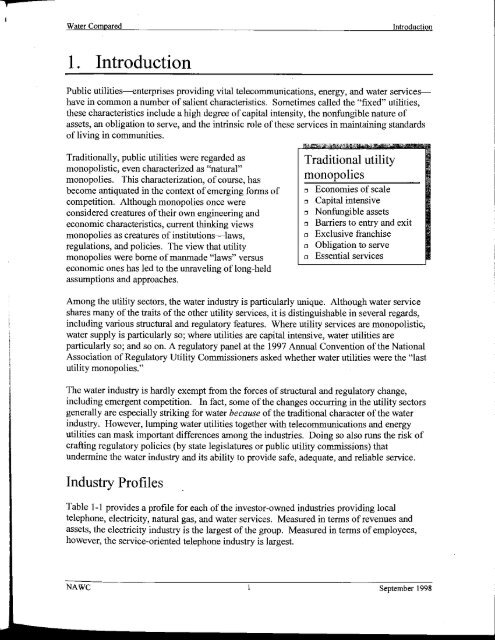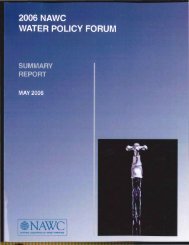BEECHER - NAWC
BEECHER - NAWC
BEECHER - NAWC
Create successful ePaper yourself
Turn your PDF publications into a flip-book with our unique Google optimized e-Paper software.
Water ComparedIntroduction1. IntroductionPublic utilities-enterprises providing vital telecommunications, energy, and water serviceshavein common a number of salient characteristics. Sometimes called the "fixed" utilities,these characteristics include a high degree of capital intensity, the nonfungible nature ofassets, an obligation to serve, and the intrinsic role of these services in maintaining standardsof living in communities.Traditionally, public utilities were regarded asmonopolistic, even characterized as "natural"monopolies. This characterization, of course, hasbecome antiquated in the context of emerging forms ofcompetition. Although monopolies once wereconsidered creatures of their own engineering andeconomic characteristics, current thinking viewsmonopolies as creatures of institutions-laws,regulations, and policies. The view that utilitymonopolies were borne of manmade "laws" versuseconomic ones has led to the unraveling of long-heldassumptions and approaches.Traditional utilitymonopolieso Economies of scaleo Capital intensiveo Nonfungible assetso Barriers to entry and exito Exclusive franchiseo Obligation to serveo Essential servicesAmong the utility sectors, the water industry is particularly unique. Although water serviceshares many of the traits ofthe other utility services, it is distinguishable in several regards,including various structural and regulatory features. Where utility services are monopolistic,water supply is particularly so; where utilities are capital intensive, water utilities areparticularly so; and so on. A regulatory panel at the 1997 Annual Convention of the NationalAssociation of Regulatory Utility Commissioners asked whether water utilities were the "lastutility monopolies."The water industry is hardly exempt from the forces of structural and regulatory change,including emergent competition. In fact, some of the changes occurring in the utility sectorsgenerally are especially striking for water because of the traditional character of the waterindustry. However, lumping water utilities together with telecommunications and energyutilities can mask important differences among the industries. Doing so also runs the risk ofcrafting regulatory policies (by state legislatures or public utility commissions) thatundermine the water industry and its ability to provide safe, adequate, and reliable service.Industry ProfilesTable 1-1 provides a profile for each of the investor-owned industries providing localtelephone, electricity, natural gas, and water services. Measured in terms of revenues andassets, the electricity industry is the largest of the group. Measured in terms of employees,however, the service-oriented telephone industry is largest.<strong>NAWC</strong> 1 September 1998
















